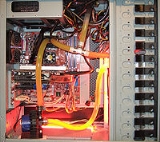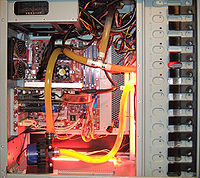
T-Line
Encyclopedia

A common use for a T-Line is in a watercooling
Watercooling
Water cooling is a method of heat removal from components and industrial equipment. As opposed to air cooling, water is used as the heat conductor. Water cooling is commonly used for cooling automobile internal combustion engines and large industrial facilities such as steam electric power plants,...
system such as those found in enthusiast PCs. The T-Line is an integral part of a do-it-yourself watercooling system alongside the traditional choice of a reservoir. Major reasons for choosing a T-Line over a standard reservoir are cost, simplicity, and space constraints.
"Fill-Ports" (example "The fillport" by DangerDen) are specifically made with T-Lines in mind, and serve the purpose of capping the T-line in an air-tight and re-openable/re-sealable fashion. They are available anodized in various colors and thus able to be tied in with color-schemes.

